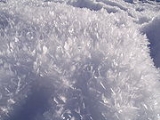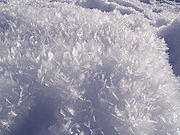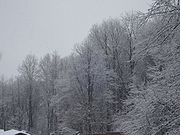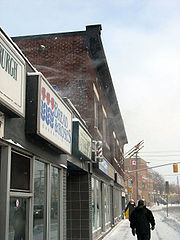
Types of snow
Encyclopedia

Blizzard
A blizzard is a severe snowstorm characterized by strong winds. By definition, the difference between blizzard and a snowstorm is the strength of the wind. To be a blizzard, a snow storm must have winds in excess of with blowing or drifting snow which reduces visibility to 400 meters or ¼ mile or...
and snow
Snow
Snow is a form of precipitation within the Earth's atmosphere in the form of crystalline water ice, consisting of a multitude of snowflakes that fall from clouds. Since snow is composed of small ice particles, it is a granular material. It has an open and therefore soft structure, unless packed by...
storm indicate heavy snowfalls over a large area, snow squalls give heavy snowfalls over narrow bands, while flurries
Snow flurry
A snow flurry is a brief instance of light snow, with very little or no accumulation of snow on the ground.-External links:* *...
are used for the lightest snowfall. Types which fall in the form of a ball, rather than a flake
Snowflake
Snowflakes are conglomerations of frozen ice crystals which fall through the Earth's atmosphere. They begin as snow crystals which develop when microscopic supercooled cloud droplets freeze. Snowflakes come in a variety of sizes and shapes. Complex shapes emerge as the flake moves through...
, are known as graupel, with sleet and snow grains as types of graupel. Once on the ground, snow can be categorized as powdery when fluffy, granular when it begins the cycle of melting and refreezing, and crud or eventually ice
Ice
Ice is water frozen into the solid state. Usually ice is the phase known as ice Ih, which is the most abundant of the varying solid phases on the Earth's surface. It can appear transparent or opaque bluish-white color, depending on the presence of impurities or air inclusions...
once it packs down into a dense drift after multiple melting and refreezing cycles. When powdering, snow drifts with the wind
Wind
Wind is the flow of gases on a large scale. On Earth, wind consists of the bulk movement of air. In outer space, solar wind is the movement of gases or charged particles from the sun through space, while planetary wind is the outgassing of light chemical elements from a planet's atmosphere into space...
, sometimes to the depth of several metres. After attaching to hillsides, blown snow can evolve into a snow slab, which is an avalanche
Avalanche
An avalanche is a sudden rapid flow of snow down a slope, occurring when either natural triggers or human activity causes a critical escalating transition from the slow equilibrium evolution of the snow pack. Typically occurring in mountainous terrain, an avalanche can mix air and water with the...
hazard on steep slopes.
While falling

Visibility
In meteorology, visibility is a measure of the distance at which an object or light can be clearly discerned. It is reported within surface weather observations and METAR code either in meters or statute miles, depending upon the country. Visibility affects all forms of traffic: roads, sailing...
. When the visibility is over 1 kilometre (0.621372736649807 mi), snow is determined to be light. Moderate snow describes snowfall with visibility restrictions between 0.5 kilometre (0.310686368324903 mi) and 1 kilometre (0.621372736649807 mi). Heavy snowfall describes conditions when visibility is restricted below 0.5 kilometre (0.310686368324903 mi). The term thundersnow
Thundersnow
Thundersnow, also known as a winter thunderstorm or a thunder snowstorm, is a relatively rare kind of thunderstorm with snow falling as the primary precipitation instead of rain. It typically falls in regions of strong upward motion within the cold sector of an extratropical cyclone...
describes a thunderstorm
Thunderstorm
A thunderstorm, also known as an electrical storm, a lightning storm, thundershower or simply a storm is a form of weather characterized by the presence of lightning and its acoustic effect on the Earth's atmosphere known as thunder. The meteorologically assigned cloud type associated with the...
which produces snow as the primary form of precipitation. A blizzard
Blizzard
A blizzard is a severe snowstorm characterized by strong winds. By definition, the difference between blizzard and a snowstorm is the strength of the wind. To be a blizzard, a snow storm must have winds in excess of with blowing or drifting snow which reduces visibility to 400 meters or ¼ mile or...
is a long-lasting snow storm with intense snowfall and usually high winds. Particularly severe storms can create whiteout
Whiteout (weather)
Whiteout is a weather condition in which visibility and contrast are severely reduced by snow or sand. The horizon disappears completely and there are no reference points at all, leaving the individual with a distorted orientation...
conditions where visibility is severely reduced. A snow storm
Winter storm
A winter storm is an event in which the dominant varieties of precipitation are formed that only occur at low temperatures, such as snow or sleet, or a rainstorm where ground temperatures are low enough to allow ice to form...
is a long storm
Storm
A storm is any disturbed state of an astronomical body's atmosphere, especially affecting its surface, and strongly implying severe weather...
of relatively heavy snow, similar to a blizzard but without the wind requirement. A snowsquall
Snowsquall
A snowsquall is a sudden moderately heavy snow fall with blowing snow and strong, gusty surface winds. It is often referred to as a whiteout and is similar to a blizzard but is localized in time or in space and snow accumulations may or may not be significant.-Lake effect snow:When arctic air...
is a brief, very intense snowstorm. A snow flurry
Snow flurry
A snow flurry is a brief instance of light snow, with very little or no accumulation of snow on the ground.-External links:* *...
describes a period of light snow with usually little accumulation with occasional moderate snowfall.
Shapes
Columns- A class of snowflakeSnowflakeSnowflakes are conglomerations of frozen ice crystals which fall through the Earth's atmosphere. They begin as snow crystals which develop when microscopic supercooled cloud droplets freeze. Snowflakes come in a variety of sizes and shapes. Complex shapes emerge as the flake moves through...
s that is shaped like a six sided column. One of the 4 classes of snowflakes.
Dendrites
Dendrite (crystal)
A crystal dendrite is a crystal that develops with a typical multi-branching tree-like form. Dendritic crystal growth is very common and illustrated by snowflake formation and frost patterns on a window. Dendritic crystallization forms a natural fractal pattern...
- A class of snowflakes that has 6 points, making it somewhat star shaped. The classic snowflake shape. One of the 4 classes of snowflakes.
Graupel
- Precipitation formed when freezing fog condenses on a snowflake, forming a ball of rime ice. Also known as snow pellets.
Ground blizzard
Ground blizzard
Ground blizzard refers to a weather condition where loose snow or ice on the ground is lifted and blown by strong winds. The primary difference between a ground blizzard as opposed to a regular blizzard is that in a ground blizzard no precipitation is produced at the time, but rather all the...
- Occurs when a strong wind drives already fallen snow to create drifts and whiteouts.
Lake-effect snow
- Produced when cold winds move across long expanses of warmer lake water, picking up water vapour which freezes and is deposited on the lake's shores.
Needles
- A class of snowflakes that are acicular in shape (their length is much longer than their diameter, like a needle). One of the 4 classes of snowflakes.
Rimed snow
Rimed snow
Rimed snow refers to snowflakes that are partially or completely coated in tiny frozen water droplets called 'rime'. Rime forms on a snowflake when it passes through a super-cooled cloud. Snowflakes that are heavily rimed typically produce very heavy and wet snow, with snow to liquid ratios in the...
- Snowflakes that are partially or completely coated in tiny frozen water droplets called rime. Rime forms on a snowflake when it passes through a super-cooled cloud. One of the 4 classes of snowflakes.
Sleet
- In CanadaCanadaCanada is a North American country consisting of ten provinces and three territories. Located in the northern part of the continent, it extends from the Atlantic Ocean in the east to the Pacific Ocean in the west, and northward into the Arctic Ocean...
and BritainUnited KingdomThe United Kingdom of Great Britain and Northern IrelandIn the United Kingdom and Dependencies, other languages have been officially recognised as legitimate autochthonous languages under the European Charter for Regional or Minority Languages...
, rain mixed with snowRain and snow mixedRain and snow mixed is precipitation composed of rain and partially melted snow. This precipitation can occur where the temperature in the lower part of the atmosphere is slightly above the freezing point...
; Some people refer to this as sleet, while others refer to sleet as ice pelletsIce pelletsIce pellets are a form of precipitation consisting of small, translucent balls of ice. Ice pellets usually are smaller than hailstones. They often bounce when they hit the ground, and generally do not freeze into a solid mass unless mixed with freezing rain...
formed when snowflakes pass through a layer of warm air, partially or completely thaw, then refreeze upon passing through sufficiently cold air during further descent.

- See graupel.
Soft hail
- See graupel.
On the ground


Snowmaking
Snowmaking is the production of snow by forcing water and pressurized air through a "snow gun" or "snow cannon", on ski slopes. Snowmaking is mainly used at ski resorts to supplement natural snow. This allows ski resorts to improve the reliability of their snow cover and to extend their ski...
- Snow can be also manufactured using snow cannons, which actually create tiny granules more like soft hail (this is sometimes called "grits" by those in the southern U.S.Southern United StatesThe Southern United States—commonly referred to as the American South, Dixie, or simply the South—constitutes a large distinctive area in the southeastern and south-central United States...
for its likeness to the texture of the foodGritsGrits are a food of American Indian origin common in the Southern United States and mainly eaten at breakfast. They consist of coarsely ground corn, or sometimes alkali-treated corn . They are also sometimes called sofkee or sofkey from the Muskogee language word...
). In recent years, snow cannons have been produced that create more natural-looking snow, but these machines are prohibitively expensive.
Blowing snow
Blowing snow
Blowing snow is snow lifted from the surface by the wind, at a height of 8 feet or more, that will reduce visibility. Blowing snow can come from falling snow or snow that already accumulated on the ground but is picked up and blown about by strong winds. It is one of the classic requirements for a...
- Snow on ground that is being moved around by wind. See ground blizzardGround blizzardGround blizzard refers to a weather condition where loose snow or ice on the ground is lifted and blown by strong winds. The primary difference between a ground blizzard as opposed to a regular blizzard is that in a ground blizzard no precipitation is produced at the time, but rather all the...
.
Chopped powder
- Powder snow that has been cut up by previous skiers.
Corn
- Coarse, granular wet snow. Most commonly used by skiers describing good spring snow. Corn is the result of diurnal cycle of melting and refreezing.
Cornice
- An overhanging formation of windblown snow. Important in skiing and alpine climbing because the overhang can be unstable and hard to see from the leeward side.
Crud
- This covers varieties of snow that all but advanced skiers find impassable. Subtypes are (a) windblown powder with irregularly shaped crust patches and ridges, (b) heavy tracked spring snow re-frozen to leave a deeply rutted surface strewn with loose blocks, (c) a deep layer of heavy snow saturated by rain (although this may go by another term). Crud is negotiated with an even weighting along the length of the skis, and smooth radius turns started, if necessary, with a pop or jump. When an advanced skier falls over on crud, it is probably because it is 'heavy crud.'
Crust
- A layer of snow on the surface of the snowpack that is stronger than the snow below, which may be powder snow. Depending on their thickness and resulting strength, crusts can be termed "supportable", meaning that they will support the weight of a human, "breakable", meaning that they will not, or "zipper", meaning that a skier can break and ski through the crust. Crusts often result from partial melting of the snow surface by direct sunlight or warm air followed by re-freezing.
Depth hoar
Depth hoar
Depth hoares are large crystals occurring at the base of a snowpack that form from when uprising water vapor freezes onto existing snow crystal. Depth hoares are sparkly large grains with facets that can be cup-shaped and that are up to 10 mm in diameter...
- Faceted snow crystals, usually poorly or completely unbonded (unsintered) to adjacent crystals, creating a weak zone in the snowpack. Depth hoar forms from metamorphism of the snowpack in response to a large temperature gradient between the warmer ground beneath the snowpack and the surface. The relatively high porosity (percentage of air space), relatively warm temperature (usually near freezing point), and unbonded weak snow in this layer can allow various organisms to live in it.
Finger drift
- A narrow snow drift (30 cm to 1 metre in width) crossing a roadway. Several finger drifts in succession resemble the fingers of a hand.
Heavy crud
- See 'Crud'.
Ice
Ice
Ice is water frozen into the solid state. Usually ice is the phase known as ice Ih, which is the most abundant of the varying solid phases on the Earth's surface. It can appear transparent or opaque bluish-white color, depending on the presence of impurities or air inclusions...
- Densely packed material formed from snow that doesn't contain air bubbles. Depending on the snow accumulation rate, the air temperature, and the weight of the snow in the upper layers, it can take snow a few hours or a few decades to form into ice.
Firn
Firn
Firn is partially-compacted névé, a type of snow that has been left over from past seasons and has been recrystallized into a substance denser than névé. It is ice that is at an intermediate stage between snow and glacial ice...
- Snow which has been lying for at least a year but which has not yet consolidated into glacier ice. It is granular.
Packed powder
- The most common snow cover on ski slopes, consisting of powder snow that has lain on the ground long enough to become compressed, but is still loose.
Packing snow
- Snow that is at or near the melting point, so that it can easily be packed into snowballs and thrown at other people or objects. This is perfect for snow fights and other winter fun, such as making a snowman, or a snow fortSnow fortA snow fort or snow castle is a usually open-topped temporary structure made of snow walls that is used for recreational purposes. Snow forts are generally built by children as a playground game or winter pastime and are used as defensive structures in snowball fights...
.
Penitentes
Penitentes
thumb|Penitentes are the name of the caps of the [[nazarenos]]; literally those doing penance for their sins.Penitentes, or nieves penitentes , are a snow formation found at high altitudes. They take the form of tall thin blades of hardened snow or ice closely spaced with the blades oriented...
- Tall blades of snow found at high altitudes.
Pillow drift
- A snow drift crossing a roadway and usually 3 to 4.5 metres (10-15 feet) in width and 30 cm to 90 cm (1-3 feet) in depth.
Powder
- Freshly fallen, uncompacted snow. The density and moisture content of powder snow can vary widely; snowfall in coastal regions and areas with higher humidity is usually heavier than a similar depth of snowfall in an arid or continental region. Light, dry (low moisture content, typically 4-7% water content) powder snow is prized by skiers and snowboarders. It is often found in the Rocky MountainsRocky MountainsThe Rocky Mountains are a major mountain range in western North America. The Rocky Mountains stretch more than from the northernmost part of British Columbia, in western Canada, to New Mexico, in the southwestern United States...
of North America and in most regions in Japan.
Slush
Slush
Slush can mean any of the following:* Slush — a slurry mixture of liquid and solid forms of water.* Slush — a pejorative and slang combination of the likewise derogatory terms slut and lush...
- Snow which partially melts upon reaching the ground, to the point that it accumulates in puddles of partially-frozen water.
Snirt
- Snow covered with dirt, which occurs most often in spring, in Prairie States like North Dakota, where strong winds pick up black topsoil from uncovered farm fields and blow it into nearby towns where the melt rate is slower. The phenomenon is almost magical; one goes to sleep with white snow outside and awakens to black snow. Also, snow that is dirty, often seen by the side of roads and parking lots near areas that have been plowed.
Snowdrift
Snowdrift
A snowdrift is a deposit of snow sculpted by wind into a mound during a snowstorm. Snowdrifts resemble sand dunes and are formed in a similar manner, namely, by wind moving light snow and depositing it when the wind is slowed, usually against a stationary object. Snow normally crests and slopes...
- Large piles of snow which occur near walls and curbs, as the wind tends to push the snow up toward the vertical surfaces.
Surface hoar
- Faceted, corn-flake shaped snow crystals that are a type of frost that forms on the surface of the snow pack on cold, clear, calm nights. Subsequent snowfall can bury layers of surface hoar, incorporating them into the snowpack where they can form a weak layer. Sometimes referred to as hoar frost.
Spring snow
Spring Snow
is a 1966 novel by Yukio Mishima, the first in his Sea of Fertility tetralogy. Mishima did extensive research, including visits to Enshō-ji in Nara, to prepare for the novel.-Plot:...
- Late in the winter season, the mid-morning sun melts the top of the frozen snow base creating a soft layer, 1-2 cm deep, that is ideal for long radius carved turns. This is spring snow. By mid-afternoon, the melted layer is likely to have become too deep for enjoyable skiing, i.e. too heavy or too slushy. On some slopes, the melt layer poses an extreme avalancheAvalancheAn avalanche is a sudden rapid flow of snow down a slope, occurring when either natural triggers or human activity causes a critical escalating transition from the slow equilibrium evolution of the snow pack. Typically occurring in mountainous terrain, an avalanche can mix air and water with the...
risk in the afternoon and ski area management will close such runs by late morning. Ideal spring snow conditions are found when the melt layer does not exceed 2cm and the diurnal cycle of melting and refreezing creates a smooth frozen surface, that does not become overly wet in the sun. An exaggerated melting and refreezing cycle results in 'corn' (see above).
Watermelon snow
Watermelon snow
Watermelon snow, also called snow algae, red snow, or blood snow, is snow that is reddish or pink in color, with the slight scent of a fresh watermelon. Watermelon snow is caused by the presence mainly of Chlamydomonas nivalis, a species of green algae containing a secondary red carotenoid pigment ...
- A reddish/pink-colored snow that smells like watermelonWatermelonWatermelon is a vine-like flowering plant originally from southern Africa. Its fruit, which is also called watermelon, is a special kind referred to by botanists as a pepo, a berry which has a thick rind and fleshy center...
s, and is caused by a red-colored green algaeGreen algaeThe green algae are the large group of algae from which the embryophytes emerged. As such, they form a paraphyletic group, although the group including both green algae and embryophytes is monophyletic...
called Chlamydomonas nivalis.
Wind slab
- A layer of relatively stiff, hard snow formed by deposition of wind blown snow on the leeward side of a ridge or other sheltered area. Wind slabs can form over weaker, softer freshly fallen powder snow, creating an avalanche hazard on steep slopes.
Zastrugi
- Snow surface features sculpted by wind into ridges and grooves
External links
- Why and How to Study a Snowcover - contains an extensive taxonomy of show terminology borrowed from Inuit and some other languages

